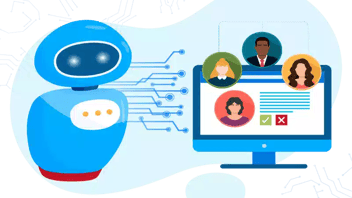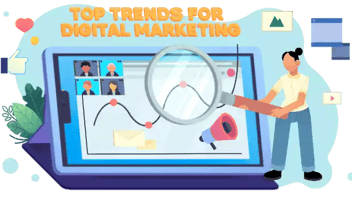Débloquer le succès : Tendances marketing clés à suivre pour 2026
À l'heure actuelle, tout le marketing est multicanal, avec des besoins à prendre en compte dans les médias sociaux, le référencement, le PPC, l'e-mail, etc. Les spécialistes du marketing et les chefs d'entreprise doivent suivre les tendances, sous peine de se retrouver irrémédiablement à la traîne. Les conseils, outils, astuces et tendances en matière de marketing numérique ne manquent pas, quel que soit le secteur d'activité. Voici nos suggestions sur les tendances à suivre au cours de l'année.

Le monde change - les tendances qui comptent
-
80 % des entreprises affirment que le marketing vidéo est une stratégie marketing importante. La vidéo est un support dynamique et influent qui permet aux entreprises de toucher un public plus large et d'établir un lien plus profond avec les clients.
-
92 % des entreprises déclarent avoir constaté une augmentation du trafic sur leur site web après avoir mis en œuvre les meilleures pratiques en matière de référencement, ce qui montre que le référencement est un outil précieux pour les entreprises de toutes tailles. En optimisant votre site web pour les moteurs de recherche, vous permettez à vos clients potentiels de vous trouver plus facilement en ligne et d'investir à long terme, en évitant à votre entreprise de dépendre de la publicité payante.
- 72 % des consommateurs affirment qu'ils sont plus enclins à acheter après avoir visionné une vidéo sur un produit ou un service. Vous pouvez améliorer considérablement vos chances de convertir des prospects en clients fidèles en utilisant des vidéos de haute qualité pour présenter vos produits ou services. Cette statistique confirme l'importance d'intégrer le marketing vidéo dans votre stratégie.
-
63 % des consommateurs déclarent qu'ils sont plus enclins à faire affaire avec une entreprise qui offre des expériences personnalisées. La personnalisation est un aspect essentiel du marketing moderne. En adaptant vos messages et vos expériences aux besoins et aux préférences de vos clients, vous pouvez créer un lien fort avec eux, qui les incitera à revenir.
-
44 % des entreprises déclarent avoir constaté une augmentation de leurs ventes après avoir mis en œuvre une stratégie de marketing de contenu. Le partage d'un contenu de qualité par le biais du marketing de contenu est une stratégie efficace pour générer des prospects et stimuler les ventes. En créant du contenu qui trouve un écho auprès de votre public cible et qui met en valeur votre expertise, vous pouvez établir la confiance et la crédibilité auprès de vos clients potentiels, en vous positionnant comme une source fiable dans votre secteur d'activité.
Utilisation accrue de l'IA et de la ML
L'intelligence artificielle (IA) et l'apprentissage machine (ML) permettent aux ordinateurs d'effectuer des tâches qui requièrent normalement l'intelligence humaine, comme l'analyse de données et la prise de décisions. Ces technologies peuvent automatiser des tâches telles que la génération de contenu, les campagnes d'e-mailing, la publicité payante et la gestion des médias sociaux dans le domaine du marketing.
L'IA et la ML peuvent également être utilisées pour analyser des données sur le comportement des consommateurs, comme les produits qu'ils ont achetés par le passé ou les publicités sur lesquelles ils ont tendance à cliquer. Ces informations peuvent aider les spécialistes du marketing à mieux comprendre leur public cible et à adapter leurs efforts en conséquence.
Par exemple, des systèmes tels que Google Gemini ou ChatGPT peuvent être formés à l'analyse des données clients et à l'identification de modèles pouvant être utilisés pour créer des campagnes de marketing personnalisées. Ces campagnes pourraient inclure des courriels ou des publicités ciblés, plus susceptibles d'être pertinents et efficaces pour chaque consommateur.
La personnalisation
La personnalisation est la pratique qui consiste à adapter les efforts de marketing aux consommateurs individuels. Cela peut impliquer l'utilisation de données et de technologies pour fournir des messages, des publicités et d'autres communications personnalisés qui sont plus pertinents et probablement plus efficaces pour chaque personne.
Lapersonnalisation peut être réalisée à l'aide de divers outils et techniques tels que la segmentation, l'analyse des données et l'apprentissage automatique. Par exemple, un spécialiste du marketing peut utiliser des données sur l'historique d'achat, les données démographiques et les centres d'intérêt d'un client pour créer des campagnes d'e-mailing personnalisées ou recommander des produits spécifiques.
Lors de la création de votre marque, la personnalisation peut contribuer à améliorer l'efficacité des efforts de marketing centrés sur le client en les rendant plus pertinents et plus attrayants pour les consommateurs. Elle peut également aider les entreprises à se démarquer sur un marché encombré, car les consommateurs sont plus susceptibles de répondre à des messages et à des communications personnalisés.
L'essor des micro-moments
Le concept de micro-moment fait référence aux courtes périodes pendant lesquelles les consommateurs se tournent vers leurs appareils pour agir sur quelque chose dont ils ont besoin ou envie. Ces moments peuvent être déclenchés par différents facteurs, tels que le désir d'apprendre quelque chose de nouveau, la nécessité de faire un achat ou le désir de se divertir.
Le marketing à l'ère des micro-moments exige de passer des campagnes à long terme à des interactions en temps réel et en fonction du contexte. Il s'agit de répondre aux besoins des consommateurs dans l'instant et dans le contexte de leur vie quotidienne, plutôt que d'essayer de les interrompre avec des messages génériques.
Pour commercialiser efficacement les micro-moments, les entreprises doivent comprendre les besoins et les préférences spécifiques de leur public cible et être en mesure de fournir des messages et des expériences pertinents et opportuns. Les données et la technologie peuvent être utilisées pour analyser le comportement des consommateurs et fournir des messages et des recommandations personnalisés.
Au-delà de l'entonnoir
De nombreux spécialistes du marketing ont totalement intégré l'entonnoir marketing comme modèle de base pour le marketing. Il semble qu'il soit temps de reconnaître que cette approche est un peu dépassée, et que c'est peut-être la raison pour laquelle vous n'obtenez pas les résultats de vente que vous souhaitez.
L'approche du marketing de la roue d'inertie pourrait bien être le prochain modèle de marketing. Présenté pour la première fois par HubSpot, ce modèle adopte une nouvelle vision du parcours de l'acheteur. Ici, tous les rôles en contact avec le client - y compris le service client, le marketing et les ventes - interagissent avec les clients à chaque étape du parcours de l'acheteur et au-delà du point d'achat.
L'entonnoir se concentre sur l'obtention de nouveaux clients et leur engagement pour les transformer en prospects quantifiables. Utiliser le volant d'inertie signifie continuer à attirer, à engager et à ravir les clients au-delà du point d'achat. Votre entreprise continue d'interagir avec les clients au lieu de les traiter comme des prospects uniques. Cela vous permet de rester en tête de liste, de sorte que les clients sont plus susceptibles de vous recommander à leur réseau.
Acheter avec les médias sociaux
Près de la moitié de la population mondiale utilise désormais les médias sociaux, ce qui rend plus ou moins obligatoire la présence de votre marque, de vos produits et de vos services sur ces plateformes. Cela a permis de raccourcir l'entonnoir des ventes en combinant les étapes allant de la prise de conscience à l'achat grâce à la prolifération de messages susceptibles d'être achetés. Un simple clic sur un bouton vous fait passer du statut d'acheteur potentiel à celui de client sur Instagram, Facebook, Pinterest et Twitter. Ces posts shoppables ont gagné du terrain et devraient être la norme dans les stratégies marketing de 2024.
Le contenu est (encore) roi.
Bien que le contenu reste important dans les stratégies de marketing de 2024, la tendance est de présenter la qualité plutôt que la quantité dans votre contenu et un contenu plus diversifié. Un contenu de haute qualité démontre votre expertise et vous permet de communiquer avec vos clients à partir d'une position d'autorité.
Diversifiez votre stratégie de contenu en variant la façon dont vous attirez les clients. Essayez de créer davantage de vidéos et de contenus interactifs. Les blogs réguliers et les autres formes de contenu écrit plus long restent précieux, car ils favorisent la visibilité et un bon référencement. De même, ils constituent un excellent moyen de montrer la personnalité de votre marque.
Gardez à l'esprit qu'une utilisation excessive, un contenu saturé ou un contenu posté uniquement pour être posté auront un impact négatif sur l'engagement. Vous n'êtes pas obligé d'avoir quelque chose à publier tous les jours. Efforcez-vous d'attirer et d'intéresser votre public tout en veillant à ne pas l'ennuyer en lui présentant un contenu de qualité médiocre ou qui se contente d'occuper l'espace.
Optimiser pour la recherche vocale
Lorsque vous essayez d'attirer l'attention d'un consommateur par le biais d'un message sur les médias sociaux, d'un article de blog ou d'une liste de résultats de moteur de recherche, vous pouvez utiliser plusieurs mots-clés pour l'aider à vous trouver. Mais lorsque le client fait des achats en utilisant, par exemple, Alexa ou Google Assistant, les seuls mots-clés pertinents se trouvent dans la commande énoncée à Alexa ou Google Assistant. Vous devez utiliser les mots les plus pertinents dans l'ensemble de votre marketing en ligne, de vos avis et de vos évaluations.
Réalité virtuelle (RV) et réalité augmentée (RA)
Il est vrai que l'utilisation de la réalité virtuelle et de la réalité augmentée dans le marketing numérique n'en est qu'à ses débuts. L'impact sera énorme, mais le moment n'est pas encore connu. Ces méthodes sont différentes et personne ne peut dire laquelle dominera.
Il y a un certain consensus sur le fait que, dans un premier temps, c'est la RA qui dominera. Un bon exemple est l'application d'IKEA, qui permet aux clients d'apporter numériquement des meubles chez eux avant de les acheter.
Pour une version simplifiée, on peut s'inspirer des filtres AR de Snapchat qui font danser des personnages partout où l'on pointe l'appareil photo. Cela permet de placer une figure ou un logo de marque directement dans l'espace personnel de chaque utilisateur.
Normal est un Chatbot
La nouveauté des chatbots va s'estomper - oupeut-être l'a-t-elle déjà fait -mais leur utilisation va se généraliser et ils seront de plus en plus faciles à utiliser. Pour prendre de l'avance, développez et mettez en œuvre un chatbot IA pour votre marque. Cela peut faire la différence entre conclure une vente ou perdre le client au profit d'un concurrent qui dispose déjà d'un chatbot facile à utiliser et qui aide les clients.
Contenu interactif
Une plus grande interactivité offre de nouvelles expériences aux acheteurs lorsqu'ils vont en ligne.
-
Le contenu interactif est différent et toujours nouveau, il se démarque donc.
-
Les visiteurs ont tendance à rester plus longtemps sur votre page lorsqu'ils sont confrontés à un contenu interactif.
-
Ce type de contenu est très facile à partager, et cette viralité contribue à renforcer la notoriété de la marque.
-
Le contenu interactif est tout simplement plus attrayant et les utilisateurs l'apprécient davantage que les autres types de contenu.
Promouvoir un contenu axé sur la communauté
Afin de créer une plus grande méritocratie pour les créateurs de contenu, Instagram a testé le fait de n'afficher les likes que pour l'auteur de l'affiche. L'objectif est d'aider à nourrir la communauté et les petits créateurs. Cette mesure reflète une tendance émergente qui consiste à privilégier la communauté plutôt que la recherche de statut.
À mesure que les plateformes se concentrent sur un contenu de qualité et adapté à la publicité, que les utilisateurs et les plateformes peuvent monétiser, il y aura un mouvement vers la promotion de la communauté et de la connexion. Il s'agit probablement d'une tendance à surveiller et à encourager au cours de l'année à venir !
Ce contenu est disponible en:
- Allemand: Die wichtigsten Marketing-Trends für 2026
- Anglais: Unlock Success: Key Marketing Trends To Follow for 2026
- Espagnol: Tendencias de marketing a seguir durante 2026
- Italien: Sblocca il successo! Segui i trend di marketing nel 2026
- Roumain: Deblocați succesul: Principalele tendințe de marketing pentru 2026
- Chinois: 开启成功之门:2026 时间值得关注的主要营销趋势










Commentez ci-dessous